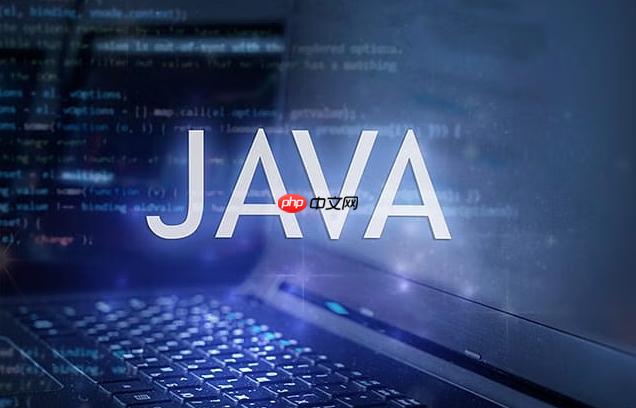引入spring security依赖;2. 创建安全配置类并定义passwordencoder、userdetailsservice和securityfilterchain bean;3. 通过authorizehttprequests配置url权限;4. 使用formlogin和logout配置登录登出逻辑;5. 可结合@enablemethodsecurity与@preauthorize实现方法级授权;6. 自定义permissionevaluator实现更细粒度的权限判断。要实现spring security权限控制,首先需在项目中添加spring-boot-starter-security等必要依赖,并创建安全配置类,在其中定义密码编码器passwordencoder用于加密存储密码,userdetailsservice用于加载用户信息(如从数据库获取),并通过securityfilterchain配置url访问规则,例如permitall允许公开访问,hasrole或hasauthority限制特定角色或权限访问,同时可启用@enablemethodsecurity注解支持方法级别权限控制,配合@preauthorize进行细粒度校验,此外还可自定义permissionevaluator实现基于业务对象的动态权限判断逻辑,从而构建完整的认证与授权体系。

Spring Security在Web应用安全领域,特别是权限控制方面,几乎是Java开发者绕不开的选择。它提供了一套强大且高度可定制的框架,帮助我们精确地定义用户能够访问哪些资源、执行哪些操作。这不仅仅是简单的登录校验,更是深入到业务逻辑层面的细粒度控制,确保每个请求都符合既定的安全策略。

解决方案
要实现一个完整的Spring Security权限控制,我们通常会围绕几个核心组件和配置展开。这就像搭建一个安全堡垒,需要地基、城墙、哨兵和内部规则。

首先,你需要引入Spring Security的依赖。对于Maven项目,这通常是spring-boot-starter-security。
org.springframework.boot spring-boot-starter-security org.springframework.boot spring-boot-starter-web org.thymeleaf.extras thymeleaf-extras-springsecurity6
接着,是核心的安全配置类。在现代Spring Boot应用中,我们通常通过定义SecurityFilterChain Bean来配置安全规则。

import org.springframework.context.annotation.Bean;
import org.springframework.context.annotation.Configuration;
import org.springframework.security.config.annotation.method.configuration.EnableMethodSecurity;
import org.springframework.security.config.annotation.web.builders.HttpSecurity;
import org.springframework.security.config.annotation.web.configuration.EnableWebSecurity;
import org.springframework.security.core.userdetails.User;
import org.springframework.security.core.userdetails.UserDetails;
import org.springframework.security.core.userdetails.UserDetailsService;
import org.springframework.security.crypto.bcrypt.BCryptPasswordEncoder;
import org.springframework.security.crypto.password.PasswordEncoder;
import org.springframework.security.provisioning.InMemoryUserDetailsManager;
import org.springframework.security.web.SecurityFilterChain;
@Configuration
@EnableWebSecurity // 启用Spring Security的Web安全功能
@EnableMethodSecurity // 启用方法级别的安全注解,如@PreAuthorize
public class SecurityConfig {
// 密码编码器,推荐使用BCryptPasswordEncoder
@Bean
public PasswordEncoder passwordEncoder() {
return new BCryptPasswordEncoder();
}
// 用户认证信息服务,这里使用内存方式,实际项目中通常会从数据库加载
@Bean
public UserDetailsService userDetailsService(PasswordEncoder passwordEncoder) {
UserDetails user = User.withUsername("user")
.password(passwordEncoder.encode("password"))
.roles("USER") // 定义角色
.build();
UserDetails admin = User.withUsername("admin")
.password(passwordEncoder.encode("adminpass"))
.roles("ADMIN", "USER") // 定义多个角色
.build();
return new InMemoryUserDetailsManager(user, admin);
}
// 安全过滤链配置
@Bean
public SecurityFilterChain securityFilterChain(HttpSecurity http) throws Exception {
http
.authorizeHttpRequests(authorize -> authorize
.requestMatchers("/public/**", "/css/**", "/js/**").permitAll() // 允许所有人访问的路径
.requestMatchers("/admin/**").hasRole("ADMIN") // 只有ADMIN角色才能访问
.requestMatchers("/user/**").hasAnyRole("USER", "ADMIN") // USER或ADMIN角色才能访问
.anyRequest().authenticated() // 任何其他请求都需要认证
)
.formLogin(form -> form
.loginPage("/login") // 自定义登录页面路径
.defaultSuccessUrl("/home", true) // 登录成功后的跳转页面
.permitAll() // 登录页面允许所有人访问
)
.logout(logout -> logout
.logoutUrl("/logout") // 登出URL
.logoutSuccessUrl("/login?logout") // 登出成功后的跳转页面
.permitAll() // 登出操作允许所有人访问
)
.csrf(csrf -> csrf.disable()); // 禁用CSRF保护,生产环境请谨慎考虑
return http.build();
}
}在上述配置中,我们定义了:
-
PasswordEncoder: 用于加密用户密码。这是最佳实践,绝不应该明文存储密码。 -
UserDetailsService: 负责加载用户认证信息(用户名、密码、角色/权限)。这里为了演示方便用了内存存储,真实项目会集成数据库。 -
SecurityFilterChain: 这是核心,定义了URL级别的访问规则、登录/登出行为等。我们通过authorizeHttpRequests配置哪些URL需要什么权限,formLogin配置表单登录,logout配置登出。
如何配置Spring Security实现用户认证与授权?
配置Spring Security进行用户认证和授权,在我看来,核心在于理解UserDetailsService和SecurityFilterChain(或旧版中的WebSecurityConfigurerAdapter)的协作。认证(Authentication)是确认“你是谁”的过程,而授权(Authorization)则是决定“你能做什么”。
首先是认证。当你尝试访问一个受保护的资源时,Spring Security会拦截请求。如果用户未认证,它会引导你到登录页面。你提交用户名和密码后,UserDetailsService就登场了。它的loadUserByUsername方法会根据你提供的用户名去查找对应的用户信息(UserDetails对象),这个对象包含了用户的密码(通常是加密后的)、角色和权限。Spring Security会用你提供的密码与UserDetails中的密码进行比对(通过PasswordEncoder),如果匹配,认证就成功了。
// 假设你从数据库加载用户信息
@Service
public class CustomUserDetailsService implements UserDetailsService {
@Autowired
private UserRepository userRepository; // 假设你有这么一个用户仓库
@Override
public UserDetails loadUserByUsername(String username) throws UsernameNotFoundException {
UserEntity user = userRepository.findByUsername(username)
.orElseThrow(() -> new UsernameNotFoundException("用户不存在: " + username));
// 将数据库中的角色/权限转换为Spring Security需要的GrantedAuthority
List authorities = user.getRoles().stream()
.map(role -> new SimpleGrantedAuthority("ROLE_" + role.getName()))
.collect(Collectors.toList());
return new org.springframework.security.core.userdetails.User(
user.getUsername(),
user.getPassword(), // 数据库中通常是BCrypt加密后的密码
authorities
);
}
} 在SecurityConfig中,你需要将这个自定义的UserDetailsService注入到认证管理器中。在新的Spring Security版本中,你只需要将@Bean注解的UserDetailsService方法放在@Configuration类中,Spring Boot会自动将其注册到全局的AuthenticationManager中。
接着是授权。一旦用户认证成功,Spring Security就知道他是谁了,接下来就是根据他的角色和权限来决定他能访问哪些资源。这主要通过SecurityFilterChain中的authorizeHttpRequests方法配置URL级别的权限控制,比如:
-
.requestMatchers("/admin/**").hasRole("ADMIN"): 只有拥有ADMIN角色的用户才能访问/admin/路径下的所有资源。 -
.requestMatchers("/products/**").hasAnyAuthority("READ_PRODUCT", "WRITE_PRODUCT"): 拥有READ_PRODUCT或WRITE_PRODUCT权限的用户可以访问。 -
.anyRequest().authenticated(): 其他所有未明确指定的请求,只要认证通过即可访问。
此外,Spring Security还支持方法级别的权限控制,这得益于@EnableMethodSecurity注解和@PreAuthorize、@PostAuthorize等注解。这让权限控制更加细致,直接作用于你的Service层或Controller层方法上。
@Service
@PreAuthorize("hasRole('ADMIN')") // 整个Service都需要ADMIN角色
public class AdminService {
@PreAuthorize("hasAuthority('admin:read')") // 方法需要admin:read权限
public String getAdminDashboard() {
return "Welcome to Admin Dashboard!";
}
@PreAuthorize("hasRole('ADMIN') and hasAuthority('admin:write')") // 组合条件
public void createNewUser(UserDto user) {
// ...
}
}这种分层级的权限控制,从URL到方法,再到更细粒度的自定义逻辑,共同构成了Spring Security的强大授权体系。
自定义权限决策器:实现更细粒度的访问控制
有时候,仅仅依靠URL路径和简单的角色判断是不足以满足复杂的业务需求的。比如,你可能需要判断用户是否是某个特定文档的创建者,或者他是否属于某个部门,才能允许他编辑该文档。这时,我们就需要引入自定义权限决策器,或者更常见的是实现PermissionEvaluator接口。

TURF(开源)权限定制管理系统(以下简称“TURF系统”),是蓝水工作室推出的一套基于软件边界设计理念研发的具有可定制性的权限管理系统。TURF系统充分考虑了易用性,将配置、设定等操作进行了图形化设计,完全在web界面实现,程序员只需在所要控制的程序中简单调用一个函数,即可实现严格的程序权限管控,管控力度除可达到文件级别外,还可达到代码级别,即可精确控制到
PermissionEvaluator允许你在@PreAuthorize注解中使用hasPermission()表达式,从而将权限判断逻辑从硬编码的URL或角色中抽离出来,放到一个专门的类中处理。这极大地提升了权限管理的灵活性和可维护性。
要实现自定义的PermissionEvaluator,你需要:
-
创建一个实现
PermissionEvaluator接口的类: 这个接口有两个核心方法:-
hasPermission(Authentication authentication, Object targetDomainObject, Object permission):用于判断用户(authentication)是否对某个领域对象(targetDomainObject)拥有特定权限(permission)。 -
hasPermission(Authentication authentication, Serializable targetId, String targetType, Object permission):与上一个类似,但通过ID和类型来引用领域对象,适用于对象尚未从数据库加载的情况。
-
import org.springframework.security.access.PermissionEvaluator;
import org.springframework.security.core.Authentication;
import org.springframework.security.core.GrantedAuthority;
import org.springframework.stereotype.Component;
import java.io.Serializable;
import java.util.Collection;
@Component
public class CustomPermissionEvaluator implements PermissionEvaluator {
// 假设你有一些服务来获取文档信息或用户与文档的关系
// @Autowired
// private DocumentService documentService;
@Override
public boolean hasPermission(Authentication authentication, Object targetDomainObject, Object permission) {
if ((authentication == null) || (targetDomainObject == null) || !(permission instanceof String)) {
return false;
}
String targetType = targetDomainObject.getClass().getSimpleName().toUpperCase();
return hasPrivilege(authentication, targetType, permission.toString().toUpperCase());
}
@Override
public boolean hasPermission(Authentication authentication, Serializable targetId, String targetType, Object permission) {
if ((authentication == null) || (targetType == null) || !(permission instanceof String)) {
return false;
}
// 这里可以根据targetId和targetType从数据库加载对象,然后进行更复杂的判断
// 例如:
// Document doc = documentService.findById(targetId);
// if (doc != null && doc.getCreatorId().equals(((MyUserDetails)authentication.getPrincipal()).getUserId())) {
// return true; // 如果是创建者,就允许
// }
return hasPrivilege(authentication, targetType.toUpperCase(), permission.toString().toUpperCase());
}
private boolean hasPrivilege(Authentication authentication, String targetType, String permission) {
// 示例:检查用户是否拥有 "READ_DOCUMENT" 或 "EDIT_DOCUMENT" 等权限
// 更复杂的逻辑可以在这里实现,比如:
// 1. 检查用户是否是管理员
// 2. 检查用户是否是资源的拥有者
// 3. 检查用户是否属于某个特定组,该组拥有此权限
// 4. 结合业务规则进行判断
Collection authorities = authentication.getAuthorities();
for (GrantedAuthority authority : authorities) {
// 简单示例:检查权限字符串是否匹配 "TARGETTYPE_PERMISSION"
if (authority.getAuthority().equals(targetType + "_" + permission)) {
return true;
}
}
return false;
}
}-
在安全配置中注册
PermissionEvaluator: 你需要将你的CustomPermissionEvaluator注册到Spring Security的MethodSecurityExpressionHandler中。
import org.springframework.security.access.expression.method.DefaultMethodSecurityExpressionHandler;
import org.springframework.security.access.expression.method.MethodSecurityExpressionHandler;
// ... 在你的SecurityConfig类中
@Bean
public MethodSecurityExpressionHandler methodSecurityExpressionHandler(CustomPermissionEvaluator customPermissionEvaluator) {
DefaultMethodSecurityExpressionHandler expressionHandler = new DefaultMethodSecurityExpressionHandler();
expressionHandler.setPermissionEvaluator(customPermissionEvaluator);
return expressionHandler;
}-
在方法上使用
@PreAuthorize("hasPermission(...)"): 现在你就可以在Service层或Controller层的方法上使用hasPermission表达式了。
@Service
public class DocumentService {
// 假设Document是一个实体类,有id和creatorId等字段
public Document getDocumentById(Long id) {
// ...
return new Document(id, 101L, "Test Document"); // 示例
}
@PreAuthorize("hasPermission(#documentId, 'Document', 'read')")
public Document readDocument(Long documentId) {
// ... 实际从数据库加载文档
System.out.println("Reading document with ID: " + documentId);
return getDocumentById(documentId);
}
@PreAuthorize("hasPermission(#document, 'edit')") // #document 是方法参数
public void updateDocument(Document document) {
// ... 更新文档逻辑
System.out.println("Updating document: " + document.getId());
}
}通过这种方式,你的权限逻辑可以变得非常灵活和强大,不再仅仅局限于简单的角色,而是能够根据具体的业务对象和操作类型进行动态判断。这对于构建复杂、安全的应用程序至关重要。
Spring Security权限控制的常见陷阱与优化策略
在实际应用Spring Security权限控制时,我们经常会遇到一些让人头疼的问题,或者在性能、可维护性上可以有更好的做法。理解这些“坑”并掌握相应的优化策略,能让你的安全堡垒更加坚固和高效。
1. 密码加密和存储不当
- 陷阱:直接存储明文密码,或者使用MD5、SHA-1等弱哈希算法。这在任何情况下都是不可接受的,一旦数据库泄露,所有用户密码将面临风险。
-
优化策略:始终使用
BCryptPasswordEncoder(或Argon2、Scrypt等更强的算法)。它内部包含了盐值(salt)和迭代次数,能有效抵御彩虹表攻击和暴力破解。确保你的PasswordEncoderBean被正确配置和使用。
2. UserDetailsService的性能瓶颈
-
陷阱:在
loadUserByUsername方法中执行了复杂的数据库查询,或者查询了过多的不必要信息,导致每次认证时性能下降。尤其在高并发场景下,这会成为系统瓶颈。 -
优化策略:
-
精简查询:
loadUserByUsername只需要获取认证和授权所需的最少信息(用户名、加密密码、角色/权限)。 -
缓存:如果用户认证信息变化不频繁,可以考虑在
UserDetailsService层引入缓存(如Ehcache、Redis),减少数据库查询次数。 - 懒加载权限:对于拥有大量权限的用户,可以考虑在需要时再加载详细权限,而不是一次性全部加载。
-
精简查询:
3. CSRF保护的理解与配置
-
陷阱:在开发或测试阶段为了方便直接
csrf().disable(),但忘记在生产环境中启用。或者不理解CSRF token的工作机制,导致前端集成问题。 -
优化策略:
- 生产环境务必启用CSRF保护。Spring Security默认是启用的。
- 理解CSRF token:对于POST、PUT、DELETE等请求,前端需要将CSRF token包含在请求头或请求体中。对于单页面应用(SPA),通常通过JavaScript从cookie中获取token并添加到请求头。
- 特殊情况处理:对于一些非浏览器客户端(如移动App、第三方API调用),它们可能无法处理CSRF token。这时可以考虑为这些特定的API路径禁用CSRF,但要确保有其他安全机制(如OAuth2 token)。
4. 权限粒度过粗或过细
-
陷阱:
- 过粗:所有管理员拥有所有权限,导致权限滥用或不符合最小权限原则。
-
过细:过度使用
@PreAuthorize,导致代码中充斥着权限判断逻辑,难以维护,且可能引发性能问题。
-
优化策略:
-
平衡原则:根据业务需求和安全风险来决定权限粒度。通常,URL级别的权限控制用于大范围的模块访问,方法级别的权限控制用于特定操作,而自定义
PermissionEvaluator则用于更复杂的业务规则判断。 - 权限组/角色:将一组相关的权限打包成角色,然后将角色分配给用户,简化管理。
- 业务抽象:将复杂的权限判断逻辑封装到独立的业务服务中,而不是直接暴露在Controller或Service方法上。
-
平衡原则:根据业务需求和安全风险来决定权限粒度。通常,URL级别的权限控制用于大范围的模块访问,方法级别的权限控制用于特定操作,而自定义
5. Session管理与并发控制
- 陷阱:不设置或设置不当的session并发控制,导致用户可以在多个地方同时登录,或者无法强制下线。
-
优化策略:
-
限制并发登录:使用
sessionManagement().maximumSessions(1).maxSessionsPreventsLogin(true)来限制用户只能单点登录。maxSessionsPreventsLogin(true)表示新登录会阻止旧登录,false则相反。 -
会话失效策略:配置
sessionManagement().invalidSessionUrl("/login?expired")等,当session失效时跳转到指定页面。 -
自定义SessionRegistry:对于需要更精细控制(如强制下线特定用户)的场景,可以实现
SessionRegistry并结合WebSocket或消息队列来实现。
-
限制并发登录:使用
6. 错误处理与用户体验
- 陷阱:权限不足时直接返回默认的403 Forbidden错误页面,用户体验差,且可能泄露路径信息。
-
优化策略:
-
自定义错误页面:通过
exceptionHandling().accessDeniedPage("/403")或accessDeniedHandler()来指定自定义的访问拒绝页面或处理逻辑。 - 友好的提示:在自定义页面中给出清晰、友好的提示,告知用户为什么无法访问,并提供帮助或联系方式。
- 日志记录:记录所有权限拒绝事件,便于审计和问题排查。
-
自定义错误页面:通过
权限控制是一个持续演进的过程,没有一劳永逸的方案。重要的是在项目初期就建立起一套清晰、可扩展的安全架构,并在开发过程中不断审视和优化。





























